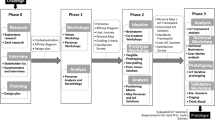Abstract
Medication errors are a common problem in healthcare, particularly in elderly individuals, who often have multiple prescriptions due to chronic diseases. At present, the design of most commercial drug packaging do not take into account the deteriorating sensory, nervous, and musculoskeletal functions of the elderly, leading to errors in taking medications as a consequence of visual and/or behavioral impairments. Attempt have been made to optimize the designs of healthcare products and services, for example, medication bags using experience-based co-design (EBCD), by involving different stakeholders such as elderly individuals; however, the elderly have mostly played passive roles during those processes. Although the elderly were consulted, they rarely in fact participated in the product design process. This study therefore combined EBCD and design thinking to establish a user-centered elder and youth co-creation (EYCC) model, the process of which included five workshops: engage, empathize, define, ideate, and prototype and test. The participants of this study included 9 individuals between the ages of 61 and 74, who themselves or their family members were suffering from chronic diseases and were taking multiple types of medications, and 8 young designers. All participants cooperated together on the redesign of medication bags. The results of this study show that the workshops in the EYCC model improved the general self-efficacy of a number of the elderly participants and significantly improved the empathy of the young designers; however, improvements in drug compliance of the elderly participants were not found. The positive findings of this study can serve as a reference for future co-creation procedures involving the elderly and youth.
Access this chapter
Tax calculation will be finalised at checkout
Purchases are for personal use only
Similar content being viewed by others
References
Abeyaratne, C., Bell, J.S., Dean, L., White, P., Maher-Sturgess, S.: Engaging older people as university-based instructors: A model to improve the empathy and attitudes of pharmacists in training. Curr. Pharmacy Teach. Learn. 12(1), 58–64 (2020)
Bandura, A.: Self-efficacy: toward a unifying theory of behavioral change. Psychol. Rev. 84(2), 191 (1977)
Bandura, A., Freeman, W.H., Lightsey, R.: Self-efficacy: The exercise of control (1999)
Bate, P., Robert, G.: Toward more user-centric OD: Lessons from the field of experience-based design and a case study. J. Appl. Behav. Sci. 43(1), 41–66 (2007)
Bate, P., Robert, G.: Experience-based design: From redesigning the system around the patient to co-designing services with the patient. BMJ Qual. Saf. 15(5), 307–310 (2006)
Chang, W.J., Chen, L.B., Hsu, C.H., Lin, C.P., Yang, T.C.: A deep learning-based intelligent medicine recognition system for chronic patients. IEEE Access 7, 44441–44458 (2019)
Chen, G., Gully, S.M., Eden, D.: Validation of a new general self-efficacy scale. Organ. Res. Methods 4(1), 62–83 (2001)
Davidson, J.L., Jensen, C.: Participatory design with older adults: an analysis of creativity in the design of mobile healthcare applications. In: Proceedings of the 9th ACM Conference on Creativity & Cognition, pp. 114–123) (2013)
Davies, E.A., O'mahony, M.S.: Adverse drug reactions in special populations–the elderly. Br. J. Clin. Pharmacol. 80(4), 796–807 (2015)
Demirbilek, O., Demirkan, H.: Universal product design involving elderly users: a participatory design model. Appl. Ergon. 35(4), 361–370 (2004)
Farquhar, M.: Elderly people’s definitions of quality of life. Soc. Sci. Med.41(10), 1439–1446 (1995)
FDA. https://www.fda.gov/drugs/information-consumers-and-patients-drugs/working-reduce-medication-errors 2019/8/23
Ford, C.M.: A theory of individual creative action in multiple social domains. Acad. Manag. Rev. 21(4), 1112–1142 (1996)
Glass, T.A., De Leon, C.M., Marottoli, R.A., Berkman, L.F.: Population based study of social and productive activities as predictors of survival among elderly Americans. Bmj 319(7208), 478–483 (1999)
Harrington, C.N., Wilcox, L., Connelly, K., Rogers, W., Sanford, J.: Designing health and fitness apps with older adults: examining the value of experience-based co-design. In: Proceedings of the 12th EAI International Conference on Pervasive Computing Technologies for Healthcare pp. 15–24 (2018)
Hickey, G., et al.: Guidance on co-producing a research project. Southampton: INVOLVE (2018)
Hogan, T.P., Awad, A.G., Eastwood, R.: A self-report scale predictive of drug compliance in schizophrenics: reliability and discriminative validity. Psychol. Med. 13(1), 177–183 (1983)
Hsiang-Lan, C.: Perceptions on Safety Medication of Caregivers Working in Disability Welfare Institutions. National Defense Medical Center School of Public Health Master’s thesis (2016)
Lee, J.M., Hirschfeld, E., Wedding, J.: A patient-designed do-it-yourself mobile technology system for diabetes: promise and challenges for a new era in medicine. Jama 315(14), 1447–1448 (2016)
Lorig, K.R., et al.: Evidence suggesting that a chronic disease self-management program can improve health status while reducing hospitalization: a randomized trial. Medical Care, 5–14 (1999)
Morisky, D.E., Green, L.W., Levine, D.M.: Concurrent and predictive validity of a self-reported measure of medication adherence. Medical Care 67–74 (1986)
Mortazavi, S.S., et al.: Defining polypharmacy in the elderly: a systematic review protocol. BMJ open 6.3 (2016)
Piper, D., Iedema, R., Gray, J., Verma, R., Holmes, L., Manning, N.: Utilizing experience-based co-design to improve the experience of patients accessing emergency departments in New South Wales public hospitals: an evaluation study. Health Serv. Manag. Res.25(4), 162–172 (2012)
Plattner, H.: An Introduction to Design Thinking Process Guide. https://dschool-old.stanford.edu/sandbox/groups/designresources/wiki/36873/attachments/74b3d/Mode GuideBOOTCAMP2010L.pdf (2010)
Spreng, R.N., McKinnon, M.C., Mar, R.A., Levine, B.: The Toronto Empathy Questionnaire: Scale development and initial validation of a factor-analytic solution to multiple empathy measures. J. Pers. Assess. 91(1), 62–71 (2009)
Stickdorn, M., Hormess, M.E., Lawrence, A., Schneider, J.: This is Service Design Doing: Applying Service Design Thinking in the Real World. O'Reilly Media, Inc (2018)
Taiwan Food and Drug Administratio. http://mohw.gov.whatis.com.tw/. Accessed 21 Apr 2016
The King's Fund 2011. http://www.kingsfund.org.uk/projects/ebcd. Accessed 15 Oct 2013
Thompson, K., Kulkarni, J., Sergejew, A.A.: Reliability and validity of a new Medication Adherence Rating Scale (MARS) for the psychoses. Schizophrenia Res. 42(3), 241–247 (2000)
Tsianakas, V., Robert, G., Maben, J., Richardson, A., Dale, C., Wiseman, T.: Implementing patient-centred cancer care: using experience-based co-design to improve patient experience in breast and lung cancer services. Supportive Care Cancer 20(11), 2639–2647 (2012)
Unni, E.J., Shiyanbola, O.O., Farris, K.B.: Change in medication adherence and beliefs in medicines over time in older adults. Global J. Health Sci. 8(5), 39 (2016)
van der Wal, M.H., Hjelmfors, L., Mårtensson, J., Friedrichsen, M., Strömberg, A., Jaarsma, T.: Variables related to communication about prognosis between nurses and patients at heart failure clinics in Sweden and the Netherlands. J. Cardiovasc. Nurs. 33(2), E1–E6 (2018)
Wang, L.: Pharmaceutical packaging design for the elderly patients. Packaging Eng. (8), 62–67 (2018)
World Health Organization.: Medication errors (2016)
Zhang, J.X., Schwarzer, R.: Measuring optimistic self-beliefs: a Chinese adaptation of the general self-efficacy scale. Psychologia: Int. J. Psychol. Orient. (1995)
Author information
Authors and Affiliations
Corresponding author
Editor information
Editors and Affiliations
Rights and permissions
Copyright information
© 2021 Springer Nature Switzerland AG
About this paper
Cite this paper
Huang, DH., Xiao, YM., Zheng, YY. (2021). Employing a User-Centered Elder and Youth Co-creation Approach for a Design of a Medication Bag: A Preliminary Study. In: Rau, PL.P. (eds) Cross-Cultural Design. Experience and Product Design Across Cultures. HCII 2021. Lecture Notes in Computer Science(), vol 12771. Springer, Cham. https://doi.org/10.1007/978-3-030-77074-7_25
Download citation
DOI: https://doi.org/10.1007/978-3-030-77074-7_25
Published:
Publisher Name: Springer, Cham
Print ISBN: 978-3-030-77073-0
Online ISBN: 978-3-030-77074-7
eBook Packages: Computer ScienceComputer Science (R0)




